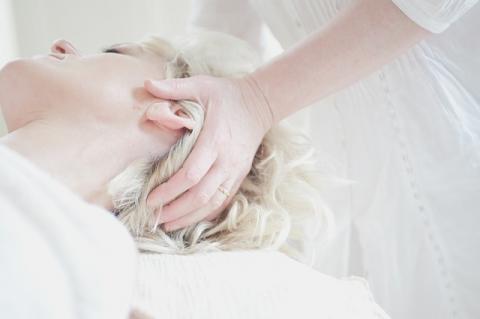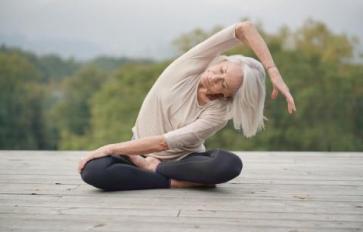
I don’t have a history of getting headaches, so when they started nagging at me, pulling at my forehead and temples by early afternoon, I took notice. Nothing in my lifestyle had changed—I was still at the same job, eating the same foods, reading and working and writing under the same lighting. At a loss to pinpoint the source of these new headaches, I decided it was the perfect time to check out craniosacral therapy.
Two years ago a yoga therapist recommended craniosacral work to balance out my body alignment. My right hip is an inch higher than the left, my jaw perpetually clenched, and the yoga therapist suggested that these two symptoms were related. At the time, I had never heard of craniosacral therapy and quickly forgot about it. Now, with my hips still uneven and a headache immune to Advil, the idea of a therapy that posits an explicit connection between the cranium (head) and the sacrum (lower spine) was appealing. I booked an appointment with Danielle Rodhouse, BA, CHT, CHBE, DFB, in Carmel, California, to see if she could help.
What is Craniosacral Therapy?
Craniosacral Therapy is a hands-on method of releasing restrictions in the body and is based on a whole-body model of care. The therapy is designed to treat a host of physical and emotional symptoms such as headaches, neck and back pain, central nervous system issues, TMJ, chronic fatigue, PTSD, and stress-related symptoms.
The modality is an offshoot of osteopathy and is based on the premise that cerebrospinal fluid, which moves from the brain through the spinal cord down to the sacrum, has a rhythm. Rodhouse starts her sessions by tuning into this craniosacral rhythm—“It’s a tangible rhythm, much like the respiratory rate or heart rate,” she explains. Because this rhythm reaches throughout the body, Rodhouse assesses from the toes all the way up to the head.
“I’m paying attention to things like, is it symmetrical on both sides? If not, is one side not as free and open as the other side? I’m checking on the quality—how strong is the rhythm, is it a smooth and even rhythm or does it feel a little disrupted?” An imbalanced craniosacral rhythm can either result in or indicate an unhealthy system. Rodhouse’s goal is to support this system in being as free and as open as possible.
Clients come to Rodhouse with concerns as varied as TMJ, headaches, back pain and hip pain. She also works with pregnant and postpartum women and with newborns, especially if there’s any type of birth trauma. But Rodhouse emphasizes that regardless of the symptom or concern, she assesses the whole body: “Just because we have a restriction in one place doesn’t mean that that’s the source of [the restriction].” Rather than treating symptoms in isolation, the practitioner considers the whole body and makes no assumptions about the client or the source of the client’s issue.
“We arrive with our clients from a very neutral space, meaning we never have an agenda or a plan for a session. We let the client’s inner wisdom guide our hands and allow the way their tissue responds to touch and release to dictate what happens in a session,” she says. “I always just try to treat what I find with my hands.”
What’s one Craniosacral Therapy session like?
The morning of my session was rainy and windy, and because the power had gone out in my home, my hair was wet, I had dressed in the dark, and I was flustered. I was relieved to hear that I was expected to let my tissue do the talking. Rodhouse explained that she would check in with me periodically to see what I was noticing in my body, but aside from those sparse verbal communications, my job was to spend the hour relaxing on a cushiony table, fully clothed, while Rodhouse did her work.
Before she even began I was feeling cozy under a blanket and eye pillow. Rodhouse started at my feet, with a touch so light I could hardly feel it at first. Although pressure varies depending on the client’s needs, the weight is often no more than that of a nickel, about 5 grams. After checking in with my thighs, hips, sacrum and diaphragm, Rodhouse placed her hands on my head. Although not a massage, the light pressure was deeply soothing, and as I felt the tension leaving my scalp, my entire body started to relax, and I realized I had been holding tension I hadn’t previously noticed, such as in my wrists, ankles, and hip flexors.
I was a little surprised when Rodhouse put a finger in each ear, gently pressing through cartilage to the bone beneath. Once I stopped wondering how gross my ears were, I relaxed into the sensation and actually enjoyed it. (I’ve since tried it on my own and find it calming).
By the end of the hour I was completely relaxed. Rodhouse explained that my occiput, at the back of my head, was restricted, especially on the left side. This was interesting to me because of other peculiarities of my left side—when I’m stressed my left eyelid twitches, my yoga therapist had told me my left jaw was tight, and in the past year I’ve had a left hamstring tear.
She said we weren’t able to fully open the craniosacral rhythm in the occiput, but had made good progress. The time she spent on my occiput had considerably opened the flow in the rest of my body.
I told Rodhouse about my high right hip and my yoga therapist’s suggestion that I manually loosen my jaw before doing a hip balancing exercise. She agreed, bunching up her shirt as a stand-in for bunching myofascia near the jaw and occiput. When the fascia, the tissue covering your muscles and bones, gets bunched at the occiput, as it seems mine is, “all the fascia begins to pull up, so [the whole] side is accommodating a restriction whose source may be up here [at the back of the head]. The result is that this right hip is pulled upward.” The bunching of tissue at the top needs to be released for the rest of the connecting tissue to release, all the way down to the toes.
I asked Rodhouse if the effects of this therapy are primarily due to the manual manipulation of the craniosacral rhythm and bodily tissues, or if, as with the concepts of prana or qi, the rhythm and its effects are energetic. Both, she said. “This isn’t energy work, per se, because we’re really working on physical things in the body, but you can’t take energy out of the equation.” The craniosacral rhythm is tangible, but it carries energy with it. This therapy works to release restrictions on physical, emotional, energetic and spiritual levels.
The Result
Ultimately, I found my session deeply grounding. Over the days following the session, my jaw seemed to hold less tension and my headaches were milder. I’m curious about how more sessions would help even out my musculature, which has always seemed to lead to injuries on my left side. I’m also intrigued by the potential of this therapy to help ward off disease by calming the central nervous system and giving our bodies the chance to get out of fight-or-flight mode.
After writing about my experience and trying to convey how craniosacral therapy works, I agree with Rodhouse that the best way to understand this modality is to experience it. To find out more about craniosacral therapy, and the other modalities Rodhouse practices, check out her website at www.daniellerodhouse.com.








